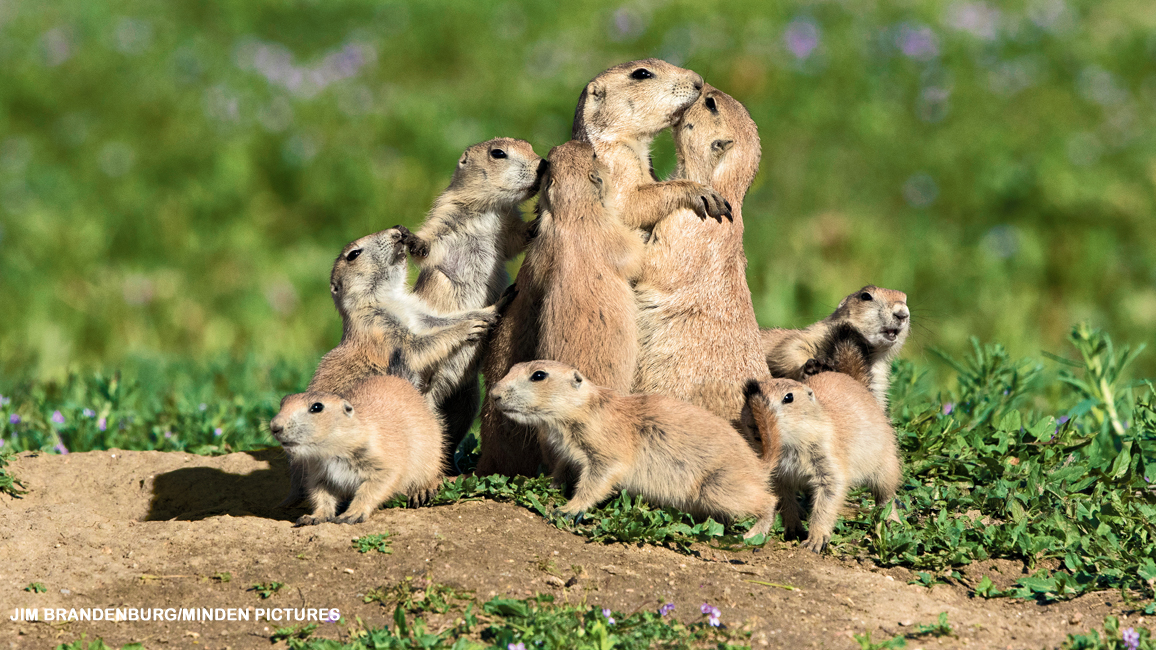
Welcome to Prairie Dog Town
By Anne CisselThey sure are cute, but did you know prairie dogs are tough, too?

Check out the bunch of black-tailed prairie dogs above. The adults are “kissing,” while a young one seems to be shoving another youngster away. It looks like something you might see in a human family. Prairie dogs kiss to find out whether they belong to the same family group. Let’s explore how these families survive together on the grasslands of North America.
This prairie dog (top right) is doing a “jump-yip” call. It lifts its front legs into the air, sticks its nose straight up, and lets out a “yip.” Once one prairie dog jump-yips, the others around it start doing it, too.
Prairie dogs build burrows, or underground tunnels, to live in. This burrow entrance has a large mound around it, which is useful as a lookout for predators. But this prairie dog knows that the bison behind it aren’t a threat—they just eat grasses and other plants.

WAIT—PRAIRIE DOGS?!
Prairie dogs are not really dogs, of course. People called them that because of the “barking” sounds they make. They are actually rodents in the ground squirrel family. Five species of prairie dogs live in North America, but the ones you see in this story are all black-tailed prairie dogs. They’re the most common.
THREATS ALL AROUND
Prairie dogs spend a lot of time munching on grasses on the open Prairie dogs live in areas that can be 100°F in summer and -35°F in winter. But their burrows stay at a comfortable temperature all year round. Some kinds of prairie dogs hibernate for about four months a year, but not black-tailed prairie dogs such as this one. plains—which makes them an easy target for a hungry enemy. Every so often, the prairie dogs stop eating and stand on their hind legs, watching for danger. They have excellent vision, which makes it easier to see the badgers, ferrets, birds of prey, foxes, snakes, and other predators looking for a meal.
Prairie dogs are noisy—making lots of squeaks, barks, and yips. If they are trying to avoid predators, why make such a racket? The calls warn their pals of danger nearby. Then they all dive into their burrows for safety.
But predators aren’t the only things that prairie dogs have to worry about. Some cattle ranchers shoot or poison prairie dogs. Why? They think the rodents eat too much of the grass that their cows need. Also, buildings and roads have taken over much of the land where prairie dogs lived. To top it all off, many of them have died from a disease they caught when bitten by infected fleas.
Prairie dogs are very important for the environment. Many animals depend on them for food. And their digging is good for the soil. It makes the soil looser, so more water can flow through and help seeds grow. And prairie dog poop acts as a fertilizer. Abandoned prairie dog burrows also make nice homes for snakes and other animals, such as burrowing owls, tiger salamanders, box turtles, and hundreds of insects and spiders. Luckily, people are trying to protect prairie dogs and their habitat.

UNDERGROUND TOWN
Prairie dog families live together in big groups called colonies, or towns. Colonies live in flat areas that contain hundreds of burrows. The burrows can be as deep as 15 feet and can extend as far as 65 feet. They keep the prairie dogs and their babies, or pups, safe from the weather and from most predators. How big are the areas where prairie dog colonies live? Imagine a football field. Most colonies live in an area about half that size. Now imagine a hundred football fields. Some prairie dog colonies sprawl out that far!
FAMILY LOVE
Prairie dogs love to be with their families. They sniff, nuzzle, and kiss each other. Black-tailed prairie dogs even groom each other, which means they clean each other’s fur. The close family ties help them survive. While one prairie dog eats, another will keep a lookout. Then they’ll switch roles.
For hundreds of years, prairie dogs have had to deal with serious challenges from predators, humans, and disease. Let’s hope that scientists can find more ways to help prairie dogs. That way, these feisty mammals can nibble, yip, and dig for a long time to come!
















